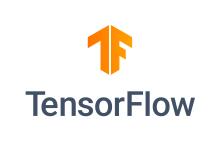TensorFlow
| 此条目包含过多行话或专业术语,可能需要简化或提出进一步解释。 |
TensorFlow是一个开源软件库,用于各种感知和语言理解任务的机器学习。[4]目前被50个团队[4]:min 0:15/2:17用于研究和生产许多Google商业产品[5]:p.2,如语音识别、Gmail、Google 相册和搜索[4]:0:26/2:17,其中许多产品曾使用过其前任软件DistBelief。
 | |
| 开发者 | 谷歌大脑团队[1] |
|---|---|
| 首次发布 | 2015年11月9日 |
| 当前版本 |
|
| 源代码库 | |
| 编程语言 | Python、C++、CUDA |
| 系统平台 | Linux、macOS、Windows、Android |
| 类型 | 机器学习库 |
| 许可协议 | Apache 2.0开源许可证 |
| 网站 | www tensorflow |
TensorFlow最初由谷歌大脑团队开发,用于Google的研究和生产,于2015年11月9日在Apache 2.0开源许可证下发布。[1][6]
历史
DistBelief
从2010年开始,谷歌大脑创建DistBelief作为他们的第一代专有的机器学习系统。50多个团队在Google和其他Alphabet公司在商业产品部署了DistBelief的深度学习神经网络,包括Google搜索、Google语音搜索、广告、Google 相册、Google地图、Google街景、Google翻译和YouTube。[5][7]Google指派计算机科学家,如杰弗里·辛顿和杰夫·迪恩,简化和重构DistBelief的代码库,使其变成一个更快、更健壮的应用级别代码库,形成了TensorFlow。[8]2009年,Hinton领导的研究小组大大减少使用DistBelief的神经网络的错误数量,通过Hinton在广义反向传播的科学突破。最值得注意的是,Hinton的突破直接使Google语音识别软件中的错误减少至少25%。[9]
TensorFlow
TensorFlow是谷歌大脑的第二代机器学习系统。
从0.8.0版本(发布于2016年4月)开始本地的支持分布式运行。
从0.9.0版本(发布于2016年6月)开始支持iOS。
从0.12.0版本(发布于2016年12月)开始支持Windows系统。该移植代码主要由微软贡献。
1.0.0版本发布于2017年2月11日。虽然参考实现运行在单台设备,TensorFlow可以运行在多个CPU和GPU(和可选的CUDA扩展和图形处理器通用计算的SYCL扩展)。[10]TensorFlow可用于64位Linux、macOS和Windows,以及移动计算平台,包括Android和iOS。
TensorFlow的计算使用有状态的数据流图表示。TensorFlow的名字来源于这类神经网络对多维数组执行的操作。这些多维数组被称为张量(Tensor)。2016年6月,Jeff Dean称在GitHub有1500个库使用了TensorFlow,其中只有5个来自Google。[11]
张量处理单元(TPU)
2016年5月,Google宣布了张量处理单元(TPU),一个专为机器学习和TensorFlow全定制的专用集成电路。TPU是一个可编程的人工智能加速器,提供高吞吐量的低精度计算(如8位),面向使用或运行模型而不是训练模型。Google宣布他们已经在数据中心中运行TPU长达一年多,发现它们对机器学习提供一个数量级更优的每瓦特性能。[12]
2017年5月Google宣布第二代张量处理单元,并在Google Compute Engine中可用。[13]第二代TPU提供最高180 teraflops性能,组装成64个TPU的集群时提供最高11.5 petaflops性能。
TensorFlow Lite
2017年5月Google宣布从Android Oreo开始,提供一个专用于Android开发的软件栈TensorFlow Lite[14]。
用于搜索引擎
Google于2015年10月26日正式发布了RankBrain,由TensorFlow支持。
TensorFlow 2
随着TensorFlow在研究论文上的市场份额因PyTorch的优势而衰减[15],在2019年9月TensorFlow团队宣布了程序库的一个新的主要版本。TensorFlow 2.0介入了很多变更,最重要的是TensorFlow eager,它将自动微分的方案,从静态计算的图,变更为“运行时定义”的方案,它最初因Chainer和后来的PyTorch而流行[15]。其他主要的变更包括移除一些旧库,在不同版本的TensorFlow的训练模型之间的交叉兼容性,还有在GPU上性能的显著改进[16]。
使用
TensorFlow充当机器学习的核心平台和函数库。TensorFlow的API使用Keras来允许用户制作自己的机器学习模型[17]。除了建造和训练它他们的模型之外,TensorFlow还能帮助装载数据来训练模型,并使用TensorFlow Serving来部署它[18]。
TensorFlow提供了一个Python API[19],以及C++[20]、Haskell[21]、Java[22]、Go[23]和Rust[24]API。第三方包可用于C#[25]、.NET Core[26]、Julia[27]、R[28]和Scala[29]。
应用
广泛的应用程序使用TensorFlow作为基础,其中它已成功实现自动化图像字幕软件,例如DeepDream。[30]2015年10月26日,Google正式启用了由TensorFlow提供支持的RankBrain。RankBrain现在处理大量的搜索查询,替换和补充传统的静态算法搜索结果。[31]
参阅
- 人工神经网络
- 深度学习框架比较
- 卷积神经网络
- 深度学习
- 机器学习
引用
- ^ 1.0 1.1 Credits. [2015-11-10]. (原始内容存档于2015-11-17).
- ^ Release 2.11.0. 2022年11月18日 [2022年11月27日].
- ^ Google 为 TensorFlow 启用 tensorflow.google.cn 域名. [2020-11-08]. (原始内容存档于2020-11-16).
- ^ 4.0 4.1 4.2 "TensorFlow: Open source machine learning" (页面存档备份,存于互联网档案馆) "It is machine learning software being used for various kinds of perceptual and language understanding tasks" — Jeffrey Dean, minute 0:47 / 2:17 from Youtube clip
- ^ 5.0 5.1 TensorFlow: Large-scale machine learning on heterogeneous systems (PDF). Google Research. 2015-11-09 [2015-11-10]. (原始内容存档 (PDF)于2015-11-20).
- ^ Google Just Open Sourced TensorFlow, Its Artificial Intelligence Engine. 2015-11-09 [2015-11-10]. (原始内容存档于2015-11-10).
- ^ Google Open-Sources The Machine Learning Tech Behind Google Photos Search, Smart Reply And More. 2015-11-09 [2015-11-11]. (原始内容存档于2015-11-10).
- ^ What Is TensorFlow, and Why Is Google So Excited About It?. 2015-11-11 [2015-11-11]. (原始内容存档于2015-11-10).
- ^ Google chairman: We’re making 'real progress' on artificial intelligence. 2015-11-25 [2015-11-25]. (原始内容存档于2015-11-25).
- ^ Metz, Cade. TensorFlow, Google's Open Source AI , Points to a Fast-Changing Hardware World. 2015-11-10 [2015-11-11]. (原始内容存档于2015-11-11).
- ^ Machine Learning: Google I/O 2016 Minute 07:30/44:44 (页面存档备份,存于互联网档案馆) accessdate=2016-06-05
- ^ Google supercharges machine learning tasks with TPU custom chip. [2016-05-19]. (原始内容存档于2016-05-18).
- ^ Build and train machine learning models on our new Google Cloud TPUs. Google. 2017-05-17 [2017-05-18]. (原始内容存档于2017-05-17) (英语).
- ^ Google’s new machine learning framework is going to put more AI on your phone. [2018-01-14]. (原始内容存档于2017-08-22).
- ^ 15.0 15.1 He, Horace. The State of Machine Learning Frameworks in 2019. The Gradient. 10 October 2019 [22 May 2020]. (原始内容存档于2019-10-10).
- ^ TensorFlow 2.0 is now available!. TensorFlow Blog. 30 September 2019 [22 May 2020]. (原始内容存档于2019-10-30).
- ^ TensorFlow Core | Machine Learning for Beginners and Experts. TensorFlow. [2021-11-04]. (原始内容存档于2023-01-20) (英语).
- ^ Introduction to TensorFlow. TensorFlow. [2021-10-28]. (原始内容存档于2023-01-20) (英语).
- ^ Python. [2022-12-12]. (原始内容存档于2022-09-05).
- ^ C++. [2022-12-12]. (原始内容存档于2023-01-20).
- ^ Haskell(页面存档备份,存于互联网档案馆)
- ^ Java(页面存档备份,存于互联网档案馆)
- ^ Go(页面存档备份,存于互联网档案馆)
- ^ Rust(页面存档备份,存于互联网档案馆)
- ^ C#(页面存档备份,存于互联网档案馆)
- ^ .NET Core(页面存档备份,存于互联网档案馆)
- ^ Julia(页面存档备份,存于互联网档案馆)
- ^ R(页面存档备份,存于互联网档案馆)
- ^ Scala(页面存档备份,存于互联网档案馆)
- ^ Google Offers Up Its Entire Machine Learning Library as Open-Source Software. 2015-11-11 [2015-11-11]. (原始内容存档于2015-11-23).
- ^ Google releases TensorFlow – Search giant makes its artificial intelligence software available to the public. 2015-11-25 [2015-11-25]. (原始内容存档于2015-11-25).
外部链接
- 官方网站
- 官方网站(简体中文)
- GitHub上的TensorFlow